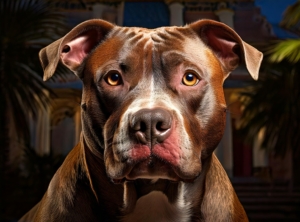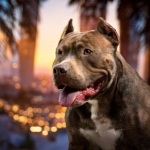Last updated on October 24th, 2024
Here’s an overview:
Introduction to Pitbulls History: A General Overview
History of the Origination of the Pitbull
The 19th century: the first dog breeds in Britain
The Arrival of Pitbulls in the American Soil: Their Drivers and Development
Fighting Dogs: A Target of Constant Apologies
BSL and Legal Issues Faced by the Owners
Pitbulls in Popular Culture: Changing the Narrative
Modern Pitbull Breeds and Their Characteristics
Training and Behavioral Insights: Modern Approaches
Health and Care Considerations for Pitbulls
Adoption and Rescue: Giving Pitbulls a Second Chance
Prominent Pitbull Advocacy and Awareness Campaigns
Conclusion: The Future And History of Pitbulls in Society
Introduction to Pitbulls History: A General Overview
Pitbulls which owe their origin to Great Britain have also undergone many changes in the course of the centuries. They are heavy and strong, faithful and active, and highly regarded among dogs. Their appearance is focused back to the 19th Century in England where they arouse as a breed combined from Bulldogs and Terriers.
Key characteristics include:
Physical Attributes:
- Strong and compact body
- Slick hair
- Large skull
Personality Traits:
- Faithful
- Bright
- Hyper
Common Misconceptions:
- Every pitbull is a mean aggressive dog
- Looked at from a perspective of the media
There is a common controlling factor among these individuals which is their training and socialization. Pitbulls have also gained popularity as family pets and working-dogs.
History of the Origination of the Pitbull
The pit bulls, as they are known today, were first recognized in the early nineteenth century in England for their use in the now infamous bull-baiting activity. The Old English Bulldog, Cross Terriers, aimed at producing a powerful and determined dog. They evolved to hunt rats and took part in dog fighting when bull baiting was prohibited in 1835. They were known as The American Pit Bull Terriers once they had been taken across to America by the immigrants. In America, their work was more on improving the speed and loyalty of these dogs. Over the years, the breed developed, as it was tempered by different uses from working dogs to the pet.
The 19th century: the first dog breeds in Britain
In nineteenth century UK the bull terrier also known as the pit bull was developed out of the fusion of bulldogs and dairy bull’s terriers. The objective of this breed was to develop a canine who would possess not just agility but strength as well. It has to be stated that bull terriers were previously developed for blood sports, leading to bull terrier then bull contextualized.
- Blood Sports: These include among other bear-baiting where a bear ties to a post while men, or more common women, throw bludgeons at it and bull baiting which is just the same.
- Legislation: The most famous of the laws is the 2035 Cruelty To Animals Act which banned those games causing more work for them.
- Working Roles: They took up herding, and guarding, and keeping pets to accompany them to the war.
- Immigration: British settlers settled Pitbulls in United States Democracy which created their further development history.
The Arrival of Pitbulls in the American Soil: Their Drivers and Development
It is fascinating to note that pitbulls received a new treatment and a new position within society in the United States from the last decade of the 17th century among the fighting bloodlinary sports to Being regarded as beloved house pets. Immigration had an impact on the evolution of Pitbull History.
Immigrant Impact, Emphasis on Uncommon Factors:
- To America by immigrants.
- Counters and companions.
The Change in America:
- Blood sports emerged.
- Pets for the households.
- Courageous and faithful.
- Gained more acceptance in urban areas.
Fighting Dogs: A Target of Constant Apologies
The engagement of the pitbull in dog fighting is trace as far back as the 19th Century.
- Beginnings: Designed by old English bull dogs with terriers for the purpose of bull baiting.
- Period of development: Eventually became an activity involving dogfighting as the activity of bull-baiting was made illegal in England in the year 1835.
- Help and Support: There was a growing tendency to take in and rehabilitate Pitbulls by certain rescue advocacy groups.
This becomes a troubling point in the Pitbull History as it affects their reputation in today’s society.
BSL and Legal Issues Faced by the Owners
Over the recent decades, Pitbulls have encountered several legal issues mainly revolving around breed specific legislation BSL. Such laws are meant to limit or prohibit the possession of particular breeds of animals believed to be vicious. Such legal issues encompass:
- Enforcement of BSL or its lack of enforcement: Some areas have strict laws while others take a more relaxed stance with some countries having an outright ban on Pitbulls.
- Safety of the people: Governments give the attack of dog and the safety of the people as the main needs for BSL.
- Criticism rather and why does BSL advocacy: There are those that oppose BSL as it profiles specific types of dogs and expect people to be accountable for their dogs on a case by case basis.
Pitbulls in Popular Culture: Changing the Narrative
In the recent years, media has started to picture these fighting dogs as caring and devoted domestic companions.
Television and Film
- “Petey” from the “Little Rascals” movie was the family pet who was ever loyal.
- The series “Pit bulls and parolees” is concerned with rescuing & rehabilitation.
- A genetically modified pet was introduce In “man’s best friend” (1993).
Literature
- In his book, “Cesar’s Way”, the author Cesar Millan devotes several chapters to rehabilitation of a breed of dogs known as the Pitbulls.
- “Lost Pet Chronicles” by Kat Albrecht mentions that pitbulls are used in search and rescue efforts.
Social Media
- Currently, use of Instagram accounts posts only fair pitbull information.
- Videos that become popular on the platform of YouTube often showcase the tricks and uses of pitbulls.
Modern Pitbull Breeds and Their Characteristics
Modern Pitbull breeds consist of several distinct types in which they possess different features.
American Pit Bull Terrier (APBT)
- Origin: United States
- Traits: Muscled loyal and strong.
- Behavior: Intelligent, sociable and energetic.
American Staffordshire Terrier (AmStaff)
- Origin: United States
- Traits: Slim, confident and balanced
- Behavior: Kind, good mannered, child-friendly and protective.
Staffordshire Bull Terrier (Staffy)
- Origin: United kingdom
- Traits: Small, tough and affectionate
- Behavior: Brave, fun and dependable.
American Bully
- Origin: United States
- Traits: Heavy, sporty and soft.
- Behavior: Friendly, relaxed and easy going.
Training and Behavioral Insights: Modern Approaches
Modern methods of training and behavioral insights for Pitbulls believe and practice effective positive reinforcement, consistent, and the need to consider the specific breed type.
- Positive Reinforcement: Making use of toys, treats and praises as rewards for certain desirable actions.
- Consistency: A routine promotes understanding of the expectation in Elaborate Pitbulls and brings down stress levels.
- Socialisation: Exposing Pitbulls to the wide world and other dogs in order to curb aggressiveness.
- Mental Stimulation: Addressing mental challenges such as utilizing puzzle toys helps enhance ones alertness.
- Professional Training: Getting some help from qualified dog handlers, especially those familiar with Pitbulls can be helpful.
- Owner Education: Owners get to appreciate the different characteristics of a Pit Bull including how best to engage it.
Health and Care Considerations for Pitbulls
An educated handling concerning health should be carried out to make sure that pit bulls live for a long and happy life.
Common Health Issues
- Hip Dysplasia: A genetic bone disease characterized by deformities in the hip bone and joints which often limits an individual’s physical movement.
- Skin Allergies: Pet owners can suffer from allergies brought about by pollen, dust, or even foods.
- Heart Disease: such diseases needs to be closely check as they can inherit in family.
Care Tips
- Exercise: Aimed at improving the physical and mental well-being.
- Diet: A diet that meets their nutritional requirements.
- Regular Vet Visits: Routine examinations in order to identify problems as soon as they develop.
Grooming Needs
- Bathing: They are bath every month to regulate the skin disorders they usually have.
- Nail Trimming: They have no pedicures done on them.
- Dental Care: They need regular brushing to avoid diseases of the teeth and gums.
Adoption and Rescue: Giving Pitbulls a Second Chance
The campaign to contain the overpopulation of Pit bulls has certainly picked up steam. Many organizations struggle to find foster homes for Pitbull insisting that they can be manage as pets.
Key Aspects
- Education Campaigns These are appropriate campaigns which aim at etching out any false beliefs about Pit bulls.
- Training Programs Such training enables an individual to improve on his or her social and behavioral skills.
All the above mentioned actions in one way or another seek to promote the proper care of Pitbulls and place them in supportive homes.
Prominent Pitbull Advocacy and Awareness Campaigns
As far back as one can remember of what people believe to be modern times, there were campaigns meant to give laws to pit bulls and make people aware:
- Best Friends Animal Society: A campaign that fights for the improvement highest quality education and improvement legislation for Pitbull’s.
- BAD RAP (Bay Area Dog lovers Responsible About Pitbull): Works to make sure the American Pit Bull Terrier has a place in every home.
- Animal Farm Foundation: Aims at working on achieving equal chances, and treatment for Pitbull breeds.
- StubbyDog: Indirectly, they build community and foster diverse storytelling to change people’s views.
- Humane Society of the United States: Politics and legislation is what they are about but so as education of the public.
These campaigns work to turn the tables and not only change stereotypes but also promote responsible pet ownership.
Conclusion: The Future And History of Pitbulls in Society
The way Pitbulls seen in society is gradually changing for the better.
- Legislation: Militating against ‘bans’ in legislation which are breed specific bsl, and a shift towards law which is based on the behavior of the animal rather than the breed.
- Advocacy: Several advocacy organizations promote their merits and press for reasonable treatment.
- Education: Scientific knowledge about pet ownership, as well as enhanced education, can alleviate some of the associated stigmas.
- Adoption Rates: The number of pitbull adoptions by shelters is gradually seeking an incline as propaganda war control is in progress.
- Media Representation: A rise in the portrayal of good images on the media leads to a change in perception on societal views.
Article by: Tawab Sukhera (Ethologist)





